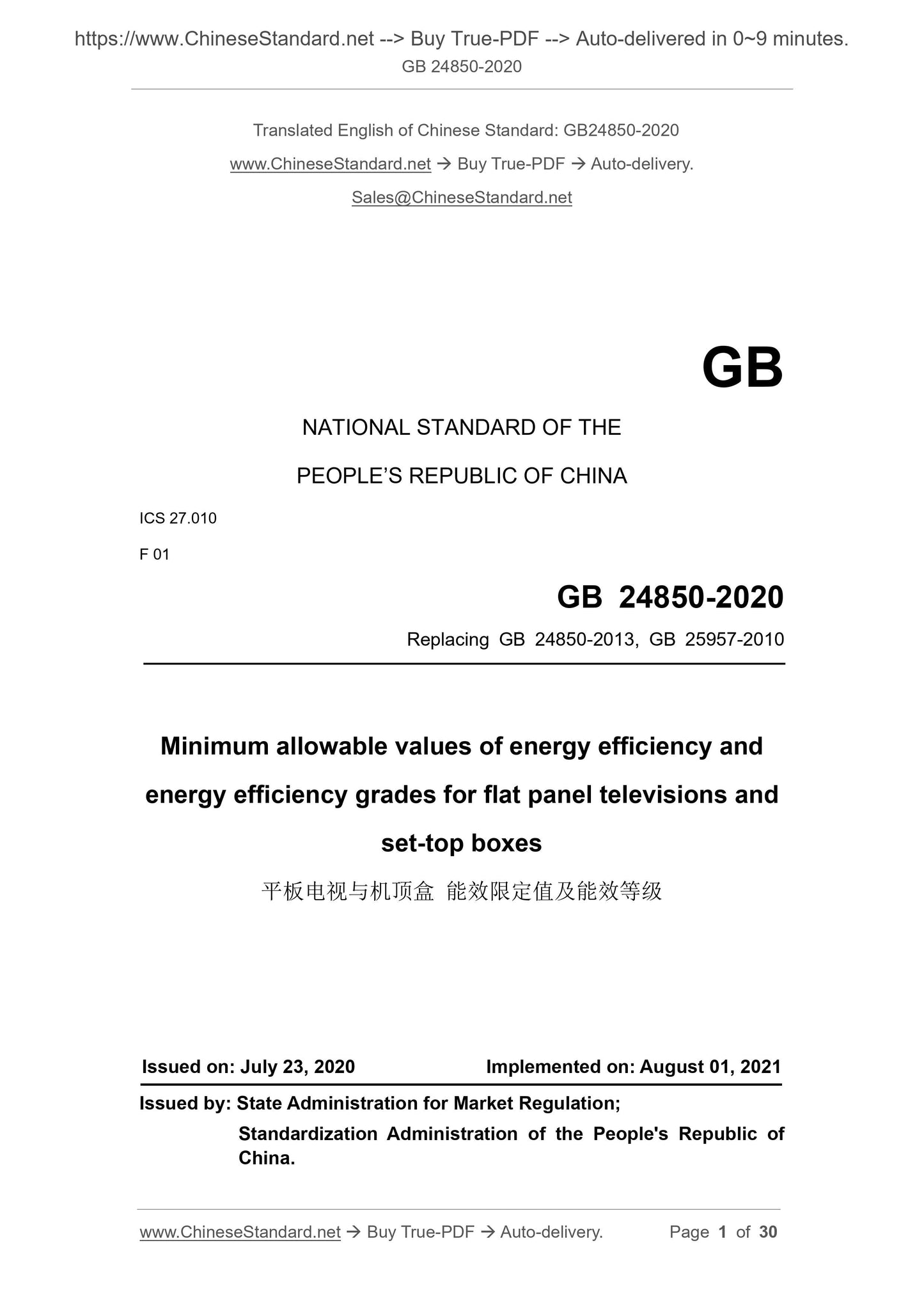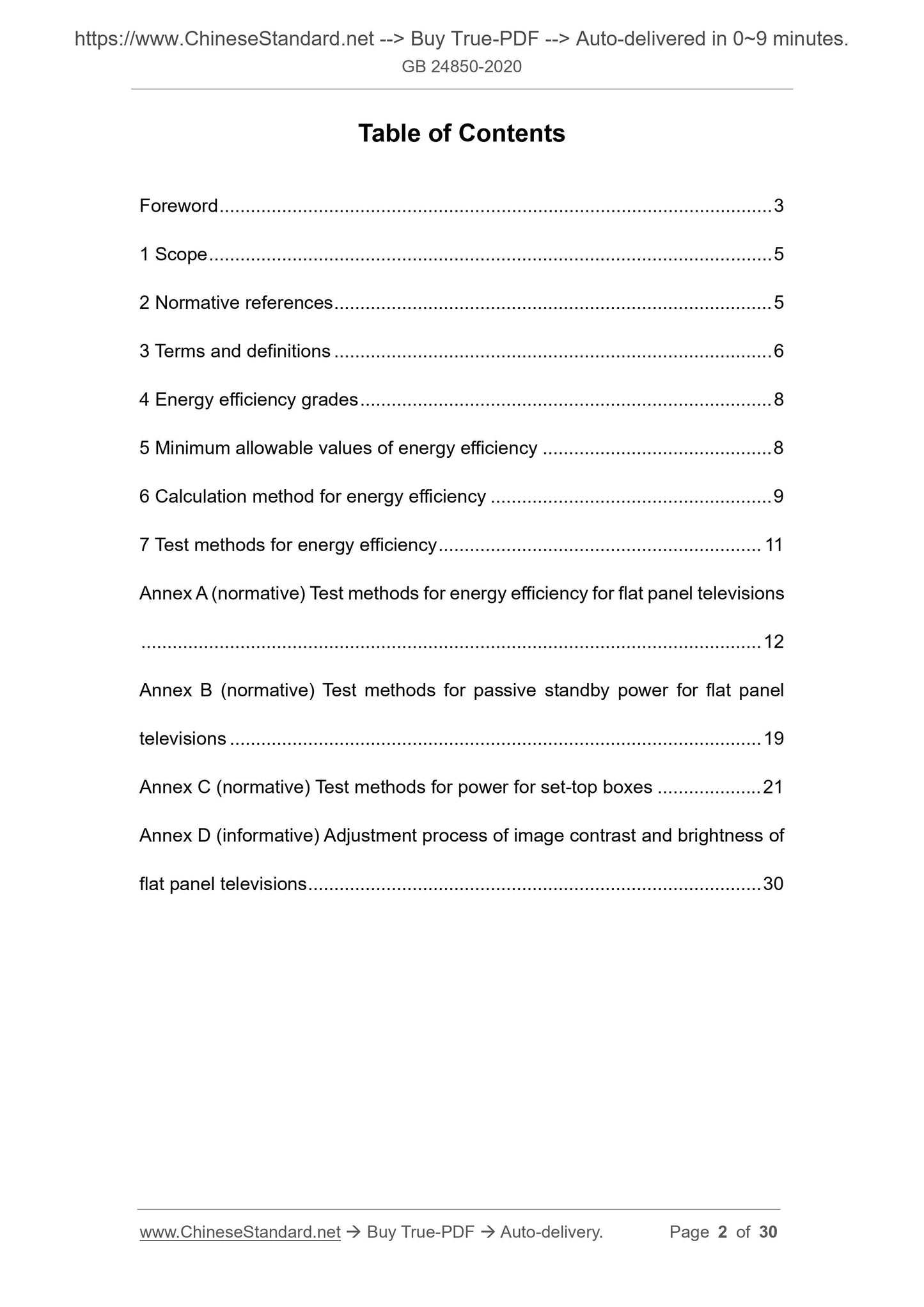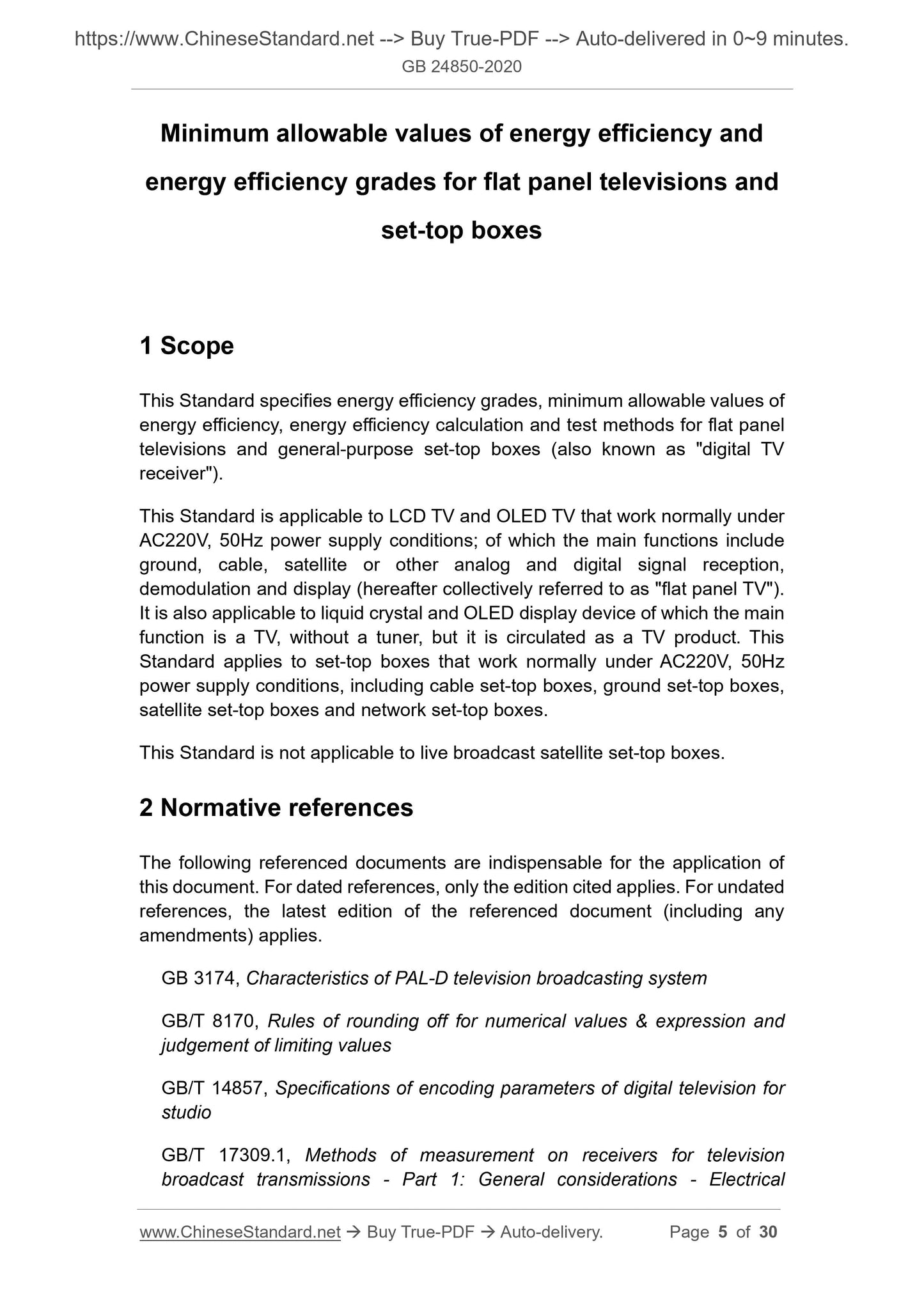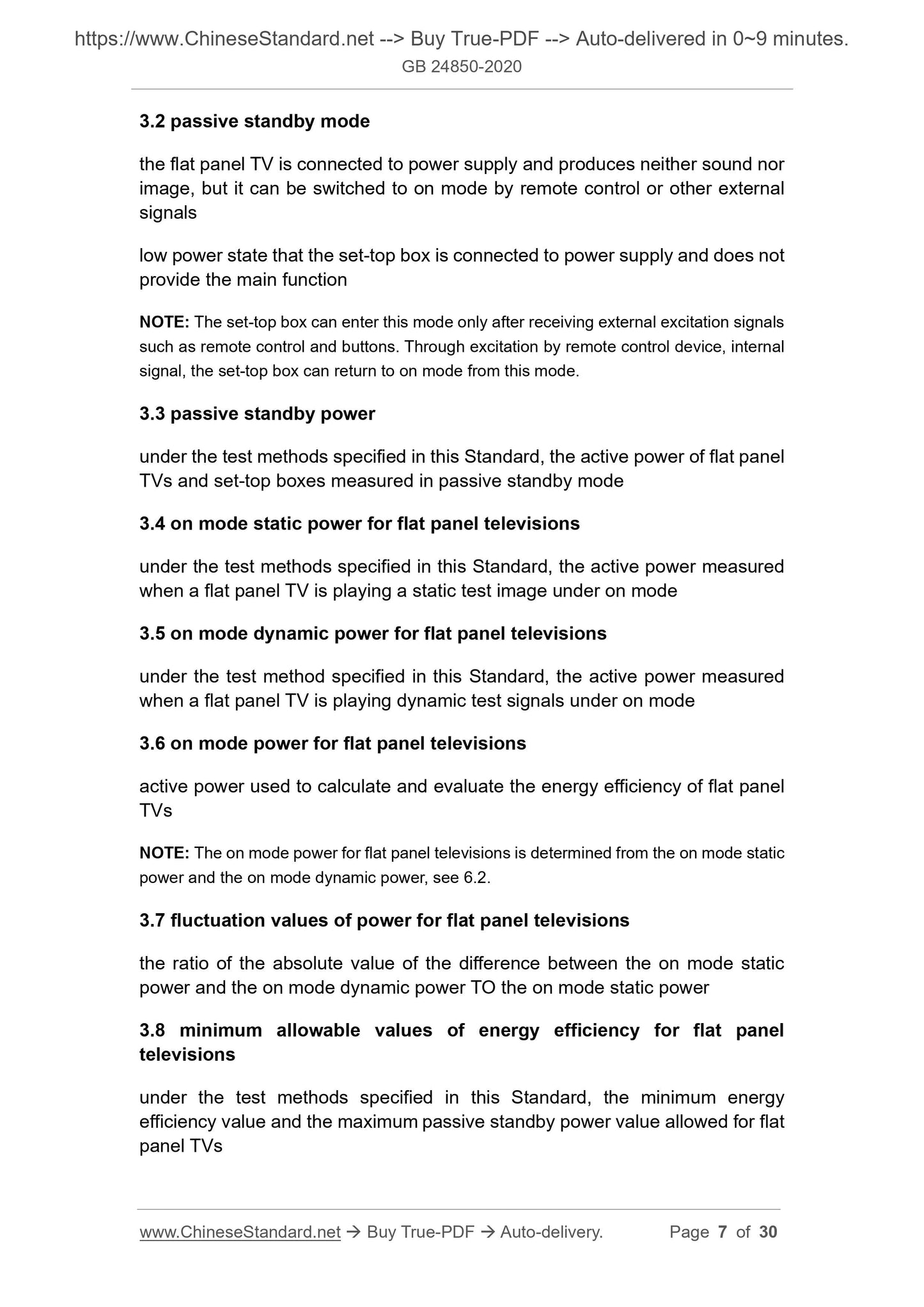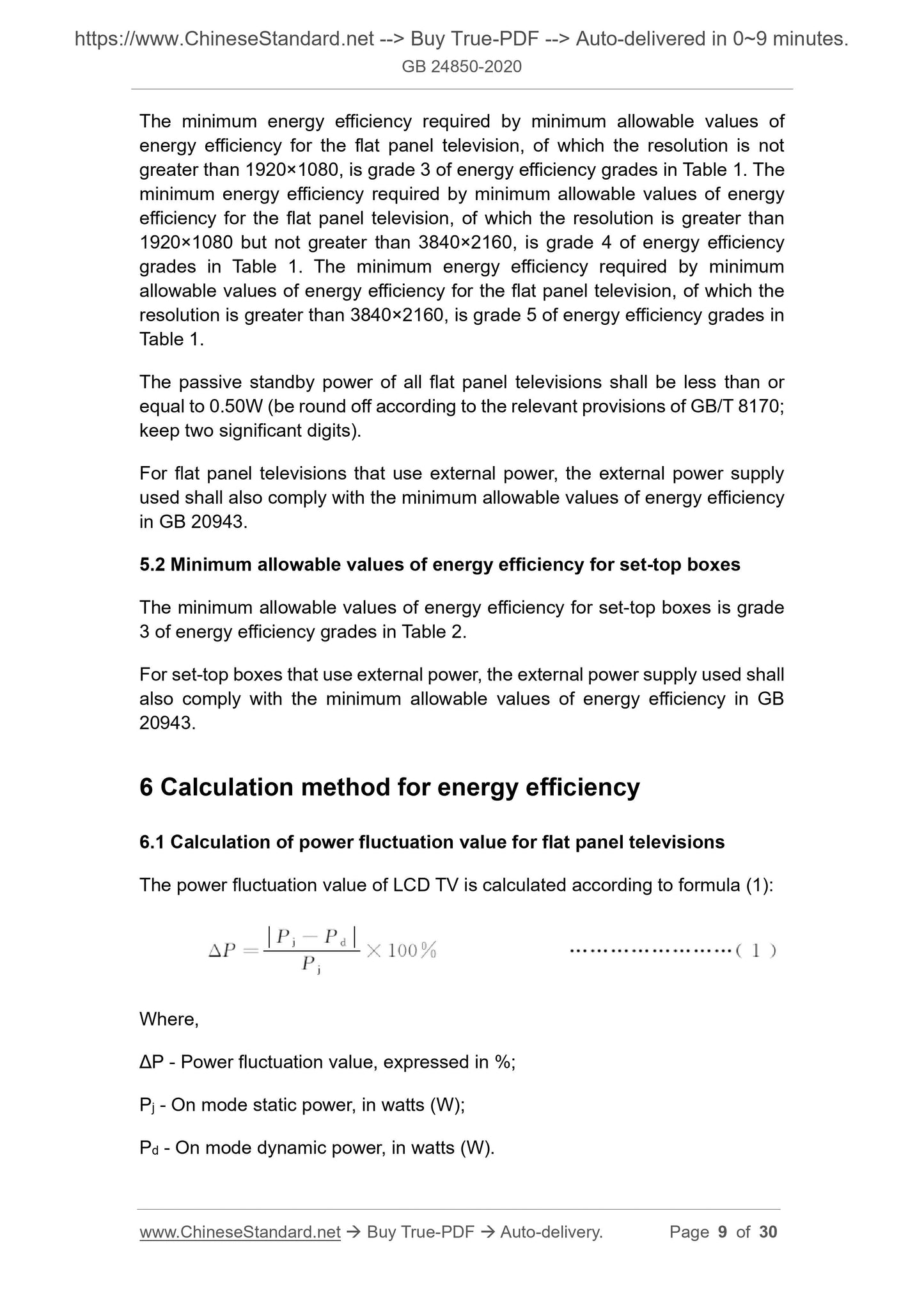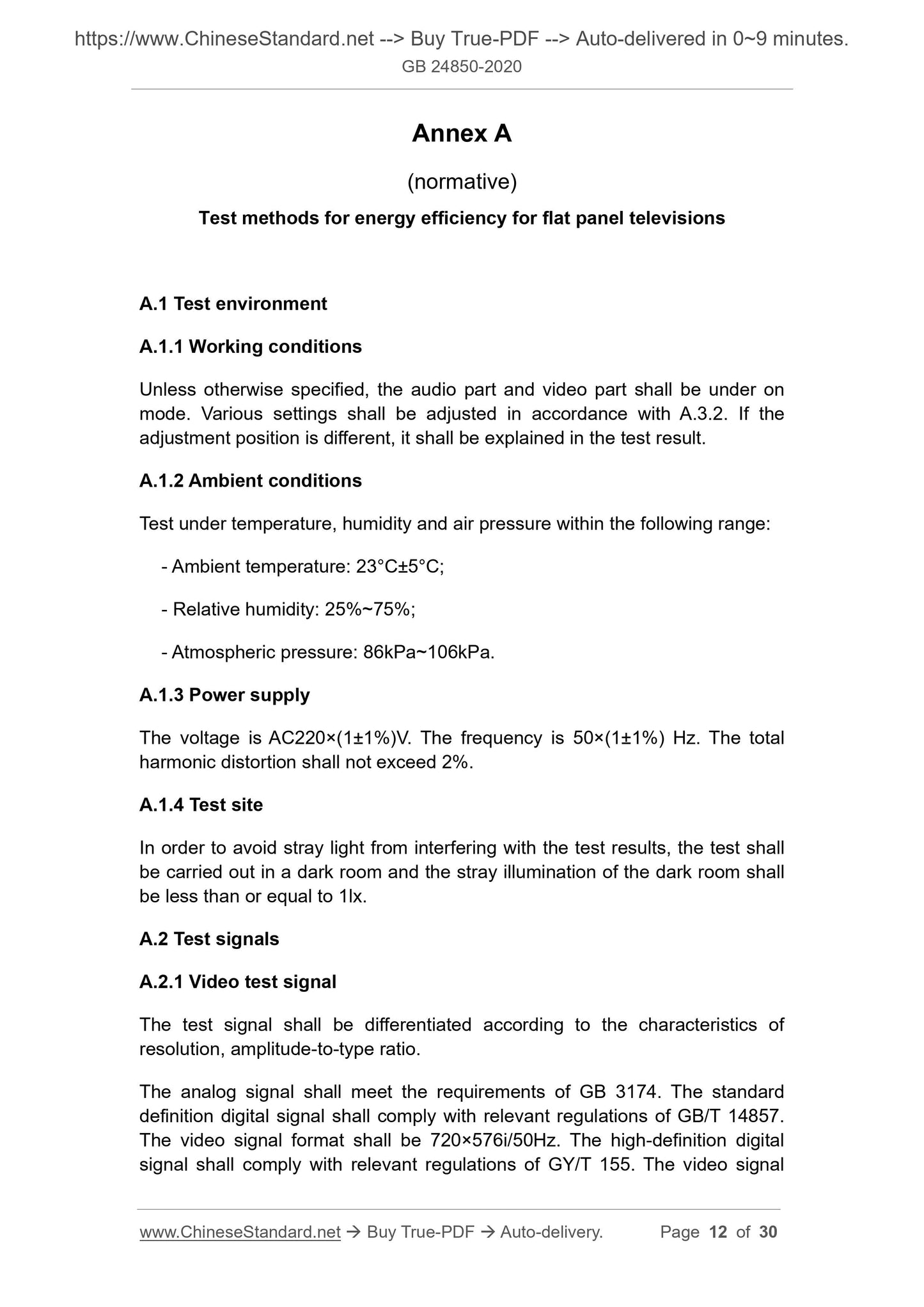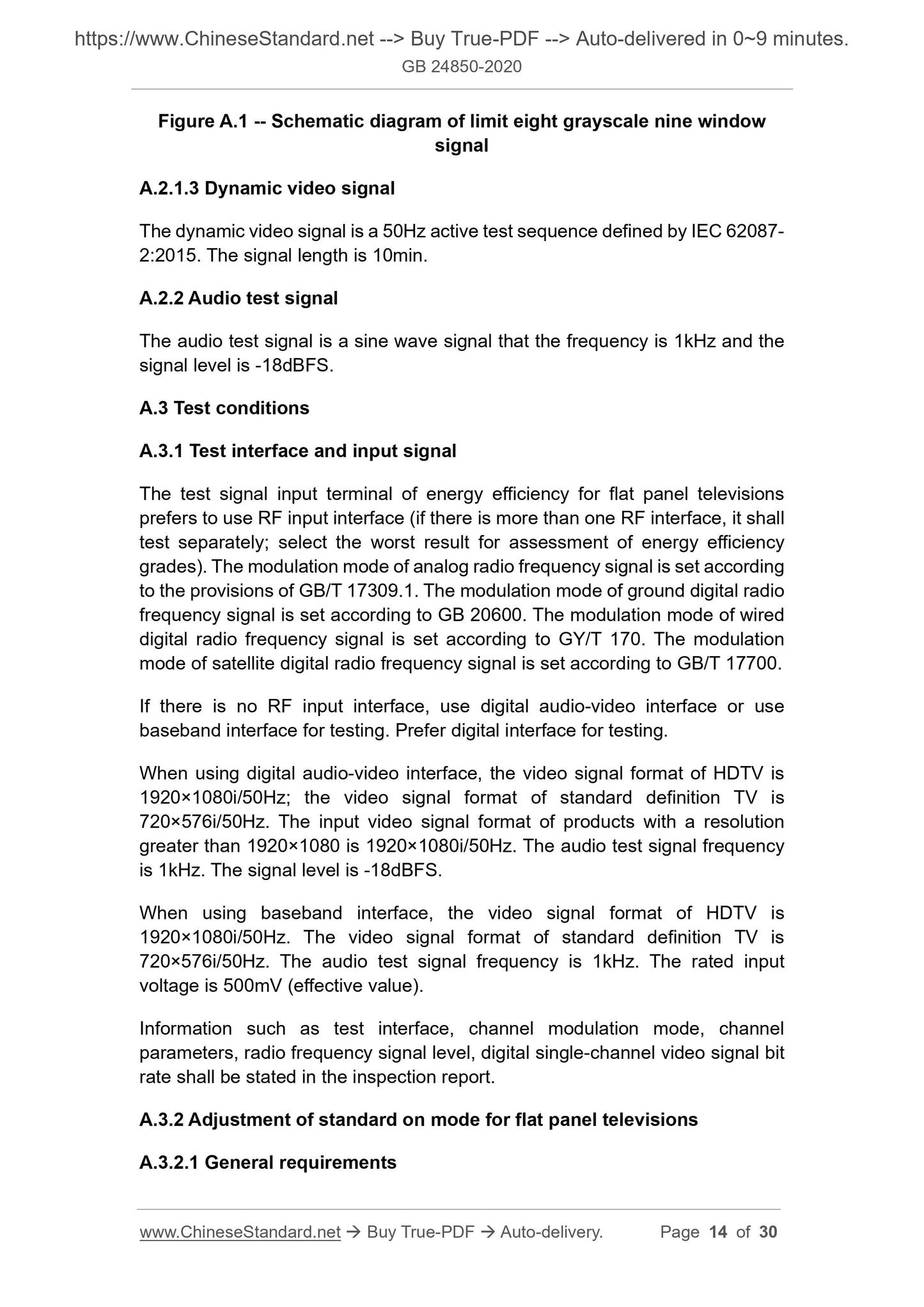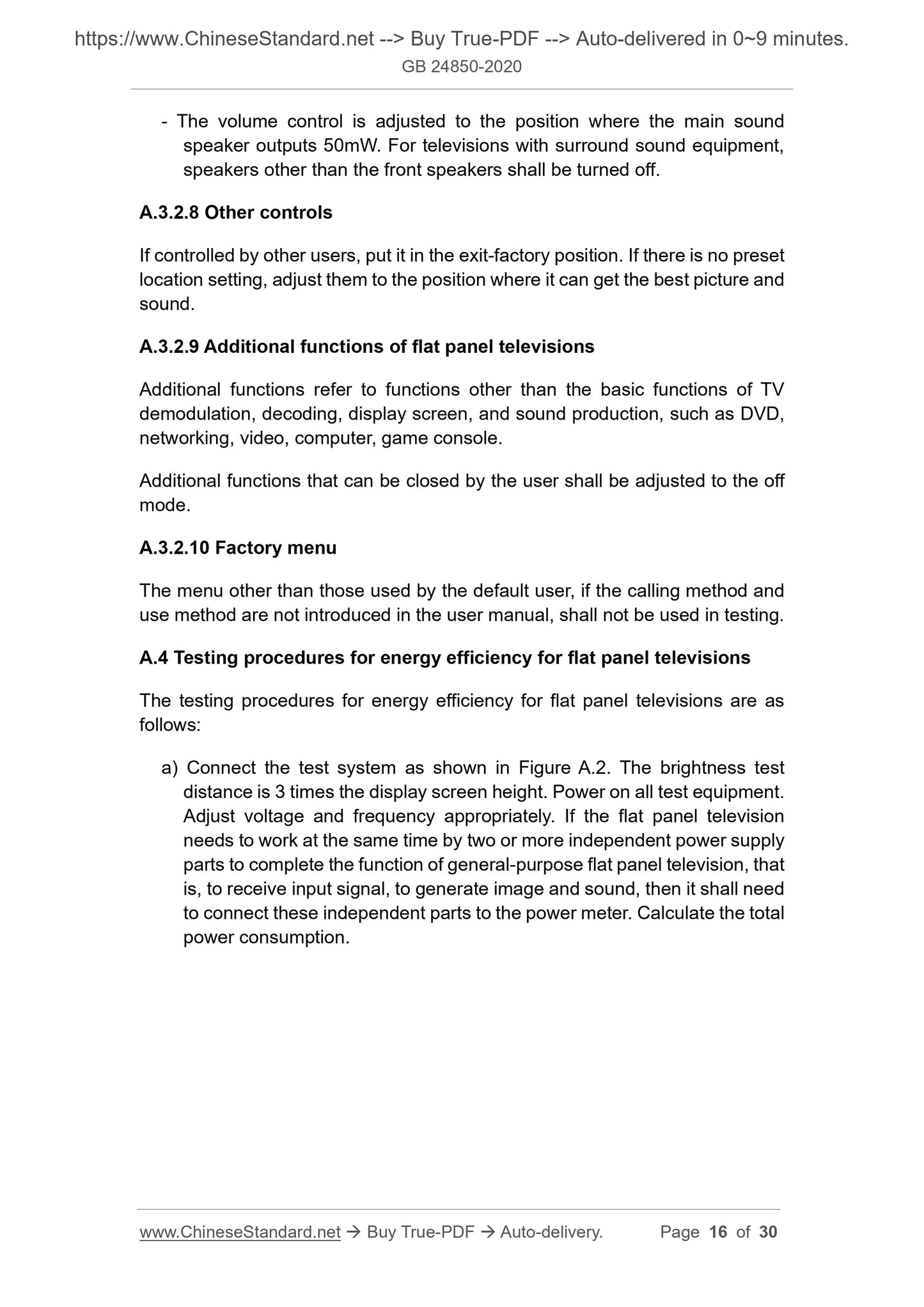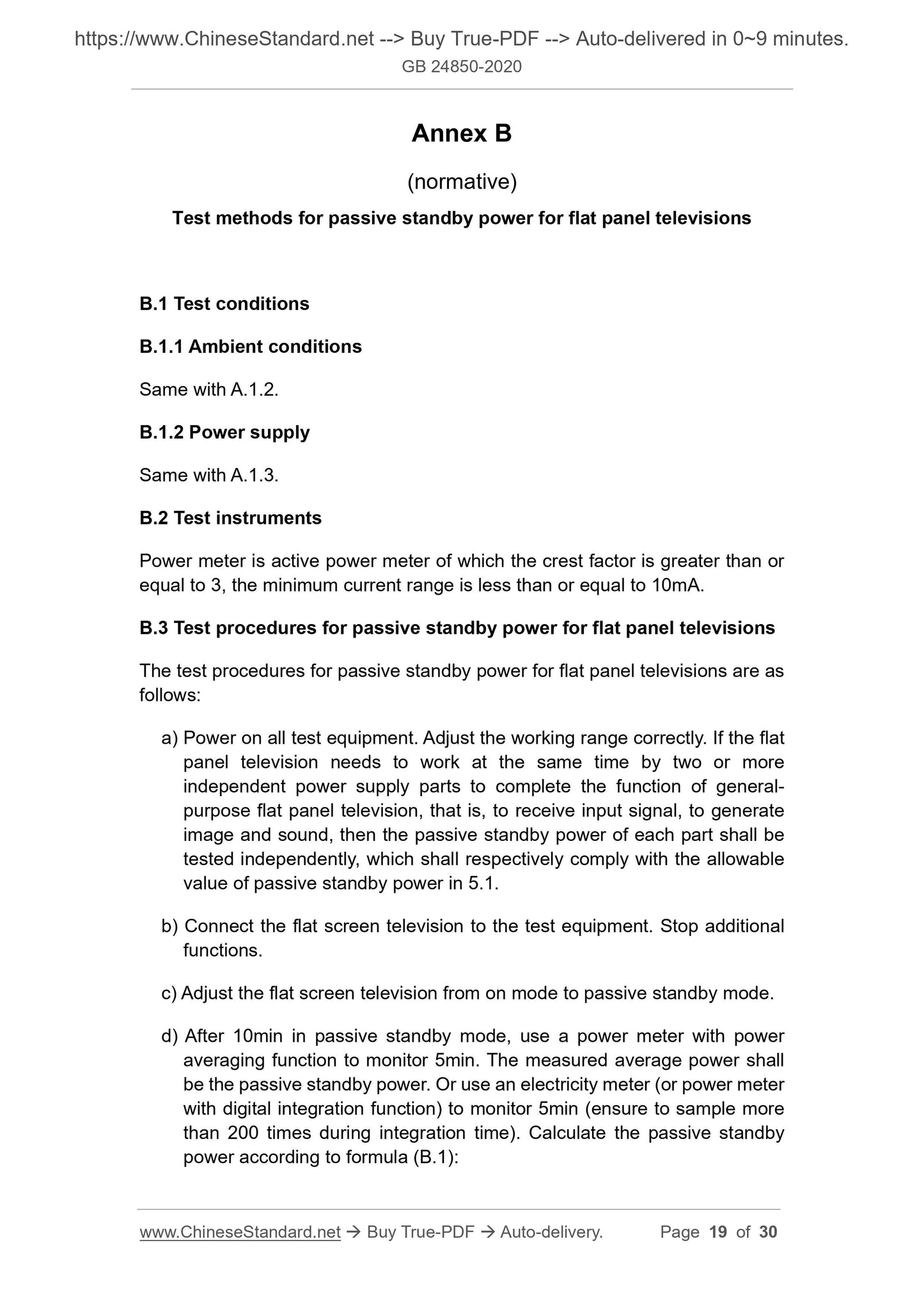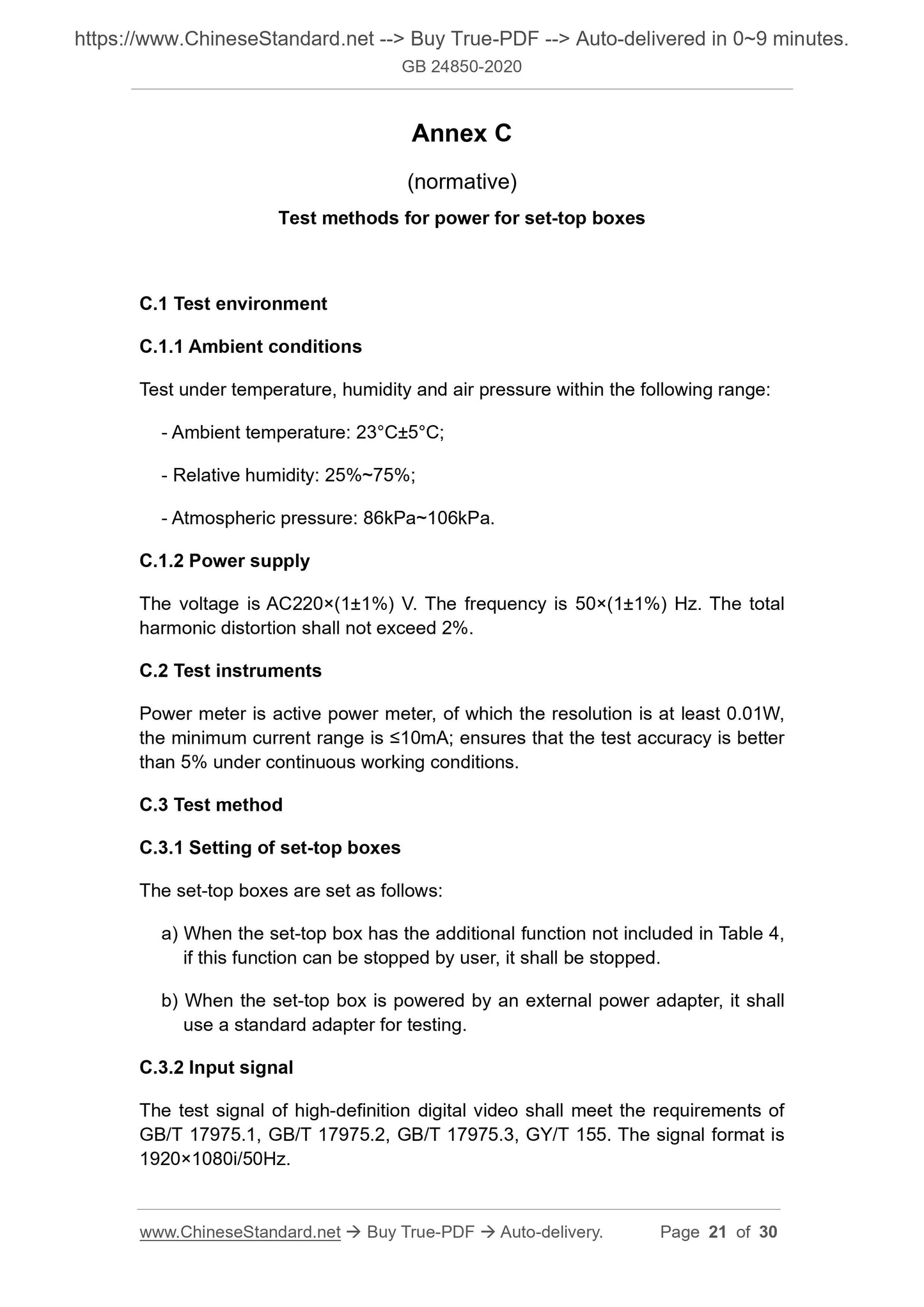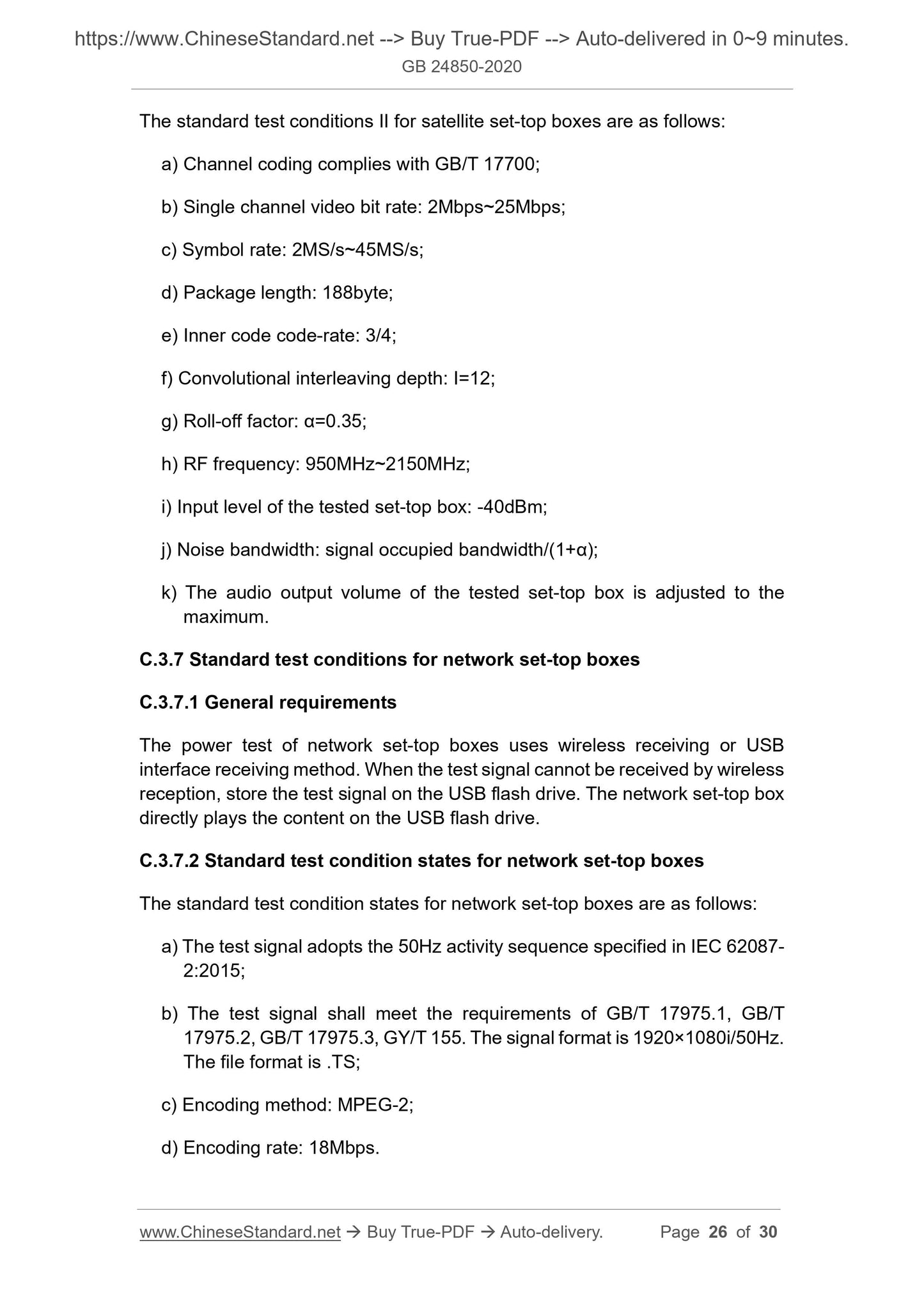1
/
of
11
www.ChineseStandard.us -- Field Test Asia Pte. Ltd.
GB 24850-2020 English PDF
GB 24850-2020 English PDF
Regular price
$805.00
Regular price
Sale price
$805.00
Unit price
/
per
Shipping calculated at checkout.
Couldn't load pickup availability
GB 24850-2020: Minimum allowable values of energy efficiency and energy efficiency grades for flat panel televisions and set-top boxes
Delivery: 9 seconds. Download (& Email) true-PDF + Invoice.
Get Quotation: Click GB 24850-2020 (Self-service in 1-minute)
Historical versions (Master-website): GB 24850-2020
Preview True-PDF (Reload/Scroll-down if blank)
GB 24850-2020
GB
NATIONAL STANDARD OF THE
PEOPLE’S REPUBLIC OF CHINA
ICS 27.010
F 01
Replacing GB 24850-2013, GB 25957-2010
Minimum allowable values of energy efficiency and
energy efficiency grades for flat panel televisions and
set-top boxes
ISSUED ON: JULY 23, 2020
IMPLEMENTED ON: AUGUST 01, 2021
Issued by: State Administration for Market Regulation;
Standardization Administration of the People's Republic of
China.
Table of Contents
Foreword ... 3
1 Scope ... 5
2 Normative references ... 5
3 Terms and definitions ... 6
4 Energy efficiency grades ... 8
5 Minimum allowable values of energy efficiency ... 8
6 Calculation method for energy efficiency ... 9
7 Test methods for energy efficiency ... 11
Annex A (normative) Test methods for energy efficiency for flat panel televisions
... 12
Annex B (normative) Test methods for passive standby power for flat panel
televisions ... 19
Annex C (normative) Test methods for power for set-top boxes ... 21
Annex D (informative) Adjustment process of image contrast and brightness of
flat panel televisions ... 30
Minimum allowable values of energy efficiency and
energy efficiency grades for flat panel televisions and
set-top boxes
1 Scope
This Standard specifies energy efficiency grades, minimum allowable values of
energy efficiency, energy efficiency calculation and test methods for flat panel
televisions and general-purpose set-top boxes (also known as "digital TV
receiver").
This Standard is applicable to LCD TV and OLED TV that work normally under
AC220V, 50Hz power supply conditions; of which the main functions include
ground, cable, satellite or other analog and digital signal reception,
demodulation and display (hereafter collectively referred to as "flat panel TV").
It is also applicable to liquid crystal and OLED display device of which the main
function is a TV, without a tuner, but it is circulated as a TV product. This
Standard applies to set-top boxes that work normally under AC220V, 50Hz
power supply conditions, including cable set-top boxes, ground set-top boxes,
satellite set-top boxes and network set-top boxes.
This Standard is not applicable to live broadcast satellite set-top boxes.
2 Normative references
The following referenced documents are indispensable for the application of
this document. For dated references, only the edition cited applies. For undated
references, the latest edition of the referenced document (including any
amendments) applies.
GB 3174, Characteristics of PAL-D television broadcasting system
GB/T 8170, Rules of rounding off for numerical values and expression and
judgement of limiting values
GB/T 14857, Specifications of encoding parameters of digital television for
studio
GB/T 17309.1, Methods of measurement on receivers for television
broadcast transmissions - Part 1: General considerations - Electrical
3.2 passive standby mode
the flat panel TV is connected to power supply and produces neither sound nor
image, but it can be switched to on mode by remote control or other external
signals
low power state that the set-top box is connected to power supply and does not
provide the main function
NOTE: The set-top box can enter this mode only after receiving external excitation signals
such as remote control and buttons. Through excitation by remote control device, internal
signal, the set-top box can return to on mode from this mode.
3.3 passive standby power
under the test methods specified in this Standard, the active power of flat panel
TVs and set-top boxes measured in passive standby mode
3.4 on mode static power for flat panel televisions
under the test methods specified in this Standard, the active power measured
when a flat panel TV is playing a static test image under on mode
3.5 on mode dynamic power for flat panel televisions
under the test method specified in this Standard, the active power measured
when a flat panel TV is playing dynamic test signals under on mode
3.6 on mode power for flat panel televisions
active power used to calculate and evaluate the energy efficiency of flat panel
TVs
NOTE: The on mode power for flat panel televisions is determined from the on mode static
power and the on mode dynamic power, see 6.2.
3.7 fluctuation values of power for flat panel televisions
the ratio of the absolute value of the difference between the on mode static
power and the on mode dynamic power TO the on mode static power
3.8 minimum allowable values of energy efficiency for flat panel
televisions
under the test methods specified in this Standard, the minimum energy
efficiency value and the maximum passive standby power value allowed for flat
panel TVs
The minimum energy efficiency required by minimum allowable values of
energy efficiency for the flat panel television, of which the resolution is not
greater than 1920×1080, is grade 3 of energy efficiency grades in Table 1. The
minimum energy efficiency required by minimum allowable values of energy
efficiency for the flat panel television, of which the resolution is greater than
1920×1080 but not greater than 3840×2160, is grade 4 of energy efficiency
grades in Table 1. The minimum energy efficiency required by minimum
allowable values of energy efficiency for the flat panel television, of which the
resolution is greater than 3840×2160, is grade 5 of energy efficiency grades in
Table 1.
The passive standby power of all flat panel televisions shall be less than or
equal to 0.50W (be round off according to the relevant provisions of GB/T 8170;
keep two significant digits).
For flat panel televisions that use external power, the external power supply
used shall also comply with the minimum allowable values of energy efficiency
in GB 20943.
5.2 Minimum allowable values of energy efficiency for set-top boxes
The minimum allowable values of energy efficiency for set-top boxes is grade
3 of energy efficiency grades in Table 2.
For set-top boxes that use external power, the external power supply used shall
also comply with the minimum allowable values of energy efficiency in GB
20943.
6 Calculation method for energy efficiency
6.1 Calculation of power fluctuation value for flat panel televisions
The power fluctuation value of LCD TV is calculated according to formula (1):
Where,
ΔP - Power fluctuation value, expressed in %;
Pj - On mode static power, in watts (W);
Pd - On mode dynamic power, in watts (W).
Annex A
(normative)
Test methods for energy efficiency for flat panel televisions
A.1 Test environment
A.1.1 Working conditions
Unless otherwise specified, the audio part and video part shall be under on
mode. Various settings shall be adjusted in accordance with A.3.2. If the
adjustment position is different, it shall be explained in the test result.
A.1.2 Ambient conditions
Test under temperature, humidity and air pressure within the following range:
- Ambient temperature: 23°C±5°C;
- Relative humidity: 25%~75%;
- Atmospheric pressure: 86kPa~106kPa.
A.1.3 Power supply
The voltage is AC220×(1±1%)V. The frequency is 50×(1±1%) Hz. The total
harmonic distortion shall not exceed 2%.
A.1.4 Test site
In order to avoid stray light from interfering with the test results, the test shall
be carried out in a dark room and the stray illumination of the dark room shall
be less than or equal to 1lx.
A.2 Test signals
A.2.1 Video test signal
The test signal shall be differentiated according to the characteristics of
resolution, amplitude-to-type ratio.
The analog signal shall meet the requirements of GB 3174. The standard
definition digital signal shall comply with relevant regulations of GB/T 14857.
The video signal format shall be 720×576i/50Hz. The high-definition digital
signal shall comply with relevant regulations of GY/T 155. The video signal
Figure A.1 -- Schematic diagram of limit eight grayscale nine window
signal
A.2.1.3 Dynamic video signal
The dynamic video signal is a 50Hz active test sequence defined by IEC 62087-
2:2015. The signal length is 10min.
A.2.2 Audio test signal
The audio test signal is a sine wave signal that the frequency is 1kHz and the
signal level is -18dBFS.
A.3 Test conditions
A.3.1 Test interface and input signal
The test signal input terminal of energy efficiency for flat panel televisions
prefers to use RF input interface (if there is more than one RF interface, it shall
test separately; select the worst result for assessment of energy efficiency
grades). The modulation mode of analog radio frequency signal is set according
to the provisions of GB/T 17309.1. The modulation mode of ground digital radio
frequency signal is set according to GB 20600. The modulation mode of wired
digital radio frequency signal is set according to GY/T 170. The modulation
mode of satellite digital radio frequency signal is set according to GB/T 17700.
If there is no RF input interface, use digital audio-video interface or use
baseband interface for testing. Prefer digital interface for testing.
When using digital audio-video interface, the video signal format of HDTV is
1920×1080i/50Hz; the video signal format of standard definition TV is
720×576i/50Hz. The input video signal format of products with a resolution
greater than 1920×1080 is 1920×1080i/50Hz. The audio test signal frequency
is 1kHz. The signal level is -18dBFS.
When using baseband interface, the video signal format of HDTV is
1920×1080i/50Hz. The video signal format of standard definition TV is
720×576i/50Hz. The audio test signal frequency is 1kHz. The rated input
voltage is 500mV (effective value).
Information such as test interface, channel modulation mode, channel
parameters, radio frequency signal level, digital single-channel video signal bit
rate shall be stated in the inspection report.
A.3.2 Adjustment of standard on mode for flat panel televisions
A.3.2.1 General requirements
- The volume control is adjusted to the position where the main sound
speaker outputs 50mW. For televisions with surround sound equipment,
speakers other than the front speakers shall be turned off.
A.3.2.8 Other controls
If controlled by other users, put it in the exit-factory position. If there is no preset
location setting, adjust them to the position where it can get the best picture and
sound.
A.3.2.9 Additional functions of flat panel televisions
Additional functions refer to functions other than the basic functions of TV
demodulation, decoding, display screen, and sound production, such as DVD,
networking, video, computer, game console.
Additional functions that can be closed by the user shall be adjusted to the off
mode.
A.3.2.10 Factory menu
The menu other than those used by the default user, if the calling method and
use method are not introduced in the user manual, shall not be used in testing.
A.4 Testing procedures for energy efficiency for flat panel televisions
The testing procedures for energy efficiency for flat panel televisions are as
follows:
a) Connect the test system as shown in Figure A.2. The brightness test
distance is 3 times the display screen height. Power on all test equipment.
Adjust voltage and frequency appropriately. If the flat panel television
needs to work at the same time by two or more independent power supply
parts to complete the function of general-purpose flat panel television, that
is, to receive input signal, to generate image and sound, then it shall need
to connect these independent parts to the power meter. Calculate the total
power consumption.
Annex B
(normative)
Test methods for passive standby power for flat panel televisions
B.1 Test conditions
B.1.1 Ambient conditions
Same with A.1.2.
B.1.2 Power supply
Same with A.1.3.
B.2 Test instruments
Power meter is active power meter of which the crest factor is greater than or
equal to 3, the minimum current range is less than or equal to 10mA.
B.3 Test procedures for passive standby power for flat panel televisions
The test procedures for passive standby power for flat panel televisions are as
follows:
a) Power on all test equipment. Adjust the working range correctly. If the flat
panel television needs to work at the same time by two or more
independent power supply parts to complete the function of general-
purpose flat panel television, that is, to receive input signal, to generate
image and sound, then the passive standby power of each part shall be
tested independently, which shall respectively comply with the allowable
value of passive standby power in 5.1.
b) Connect the flat screen television to the test equipment. Stop additional
functions.
c) Adjust the flat screen television from on mode to passive standby mode.
d) After 10min in passive standby mode, use a power meter with power
averaging function to monitor 5min. The measured average power shall
be the passive standby power. Or use an electricity meter (or power meter
with digital integration function) to monitor 5min (ensure to sample more
than 200 times during integration time). Calculate the passive standby
power according to formula (B.1):
Annex C
(normative)
Test methods for power for set-top boxes
C.1 Test environment
C.1.1 Ambient conditions
Test under temperature, humidity and air pressure within the following range:
- Ambient temperature: 23°C±5°C;
- Relative humidity: 25%~75%;
- Atmospheric pressure: 86kPa~106kPa.
C.1.2 Power supply
The voltage is AC220×(1±1%) V. The frequency is 50×(1±1%) Hz. The total
harmonic distortion shall not exceed 2%.
C.2 Test instruments
Power meter is active power meter, of which the resolution is at least 0.01W,
the minimum current range is ≤10mA; ensures that the test accuracy is better
than 5% under continuous working conditions.
C.3 Test method
C.3.1 Setting of set-top boxes
The set-top boxes are set as follows:
a) When the set-top box has the additional function ...
Delivery: 9 seconds. Download (& Email) true-PDF + Invoice.
Get Quotation: Click GB 24850-2020 (Self-service in 1-minute)
Historical versions (Master-website): GB 24850-2020
Preview True-PDF (Reload/Scroll-down if blank)
GB 24850-2020
GB
NATIONAL STANDARD OF THE
PEOPLE’S REPUBLIC OF CHINA
ICS 27.010
F 01
Replacing GB 24850-2013, GB 25957-2010
Minimum allowable values of energy efficiency and
energy efficiency grades for flat panel televisions and
set-top boxes
ISSUED ON: JULY 23, 2020
IMPLEMENTED ON: AUGUST 01, 2021
Issued by: State Administration for Market Regulation;
Standardization Administration of the People's Republic of
China.
Table of Contents
Foreword ... 3
1 Scope ... 5
2 Normative references ... 5
3 Terms and definitions ... 6
4 Energy efficiency grades ... 8
5 Minimum allowable values of energy efficiency ... 8
6 Calculation method for energy efficiency ... 9
7 Test methods for energy efficiency ... 11
Annex A (normative) Test methods for energy efficiency for flat panel televisions
... 12
Annex B (normative) Test methods for passive standby power for flat panel
televisions ... 19
Annex C (normative) Test methods for power for set-top boxes ... 21
Annex D (informative) Adjustment process of image contrast and brightness of
flat panel televisions ... 30
Minimum allowable values of energy efficiency and
energy efficiency grades for flat panel televisions and
set-top boxes
1 Scope
This Standard specifies energy efficiency grades, minimum allowable values of
energy efficiency, energy efficiency calculation and test methods for flat panel
televisions and general-purpose set-top boxes (also known as "digital TV
receiver").
This Standard is applicable to LCD TV and OLED TV that work normally under
AC220V, 50Hz power supply conditions; of which the main functions include
ground, cable, satellite or other analog and digital signal reception,
demodulation and display (hereafter collectively referred to as "flat panel TV").
It is also applicable to liquid crystal and OLED display device of which the main
function is a TV, without a tuner, but it is circulated as a TV product. This
Standard applies to set-top boxes that work normally under AC220V, 50Hz
power supply conditions, including cable set-top boxes, ground set-top boxes,
satellite set-top boxes and network set-top boxes.
This Standard is not applicable to live broadcast satellite set-top boxes.
2 Normative references
The following referenced documents are indispensable for the application of
this document. For dated references, only the edition cited applies. For undated
references, the latest edition of the referenced document (including any
amendments) applies.
GB 3174, Characteristics of PAL-D television broadcasting system
GB/T 8170, Rules of rounding off for numerical values and expression and
judgement of limiting values
GB/T 14857, Specifications of encoding parameters of digital television for
studio
GB/T 17309.1, Methods of measurement on receivers for television
broadcast transmissions - Part 1: General considerations - Electrical
3.2 passive standby mode
the flat panel TV is connected to power supply and produces neither sound nor
image, but it can be switched to on mode by remote control or other external
signals
low power state that the set-top box is connected to power supply and does not
provide the main function
NOTE: The set-top box can enter this mode only after receiving external excitation signals
such as remote control and buttons. Through excitation by remote control device, internal
signal, the set-top box can return to on mode from this mode.
3.3 passive standby power
under the test methods specified in this Standard, the active power of flat panel
TVs and set-top boxes measured in passive standby mode
3.4 on mode static power for flat panel televisions
under the test methods specified in this Standard, the active power measured
when a flat panel TV is playing a static test image under on mode
3.5 on mode dynamic power for flat panel televisions
under the test method specified in this Standard, the active power measured
when a flat panel TV is playing dynamic test signals under on mode
3.6 on mode power for flat panel televisions
active power used to calculate and evaluate the energy efficiency of flat panel
TVs
NOTE: The on mode power for flat panel televisions is determined from the on mode static
power and the on mode dynamic power, see 6.2.
3.7 fluctuation values of power for flat panel televisions
the ratio of the absolute value of the difference between the on mode static
power and the on mode dynamic power TO the on mode static power
3.8 minimum allowable values of energy efficiency for flat panel
televisions
under the test methods specified in this Standard, the minimum energy
efficiency value and the maximum passive standby power value allowed for flat
panel TVs
The minimum energy efficiency required by minimum allowable values of
energy efficiency for the flat panel television, of which the resolution is not
greater than 1920×1080, is grade 3 of energy efficiency grades in Table 1. The
minimum energy efficiency required by minimum allowable values of energy
efficiency for the flat panel television, of which the resolution is greater than
1920×1080 but not greater than 3840×2160, is grade 4 of energy efficiency
grades in Table 1. The minimum energy efficiency required by minimum
allowable values of energy efficiency for the flat panel television, of which the
resolution is greater than 3840×2160, is grade 5 of energy efficiency grades in
Table 1.
The passive standby power of all flat panel televisions shall be less than or
equal to 0.50W (be round off according to the relevant provisions of GB/T 8170;
keep two significant digits).
For flat panel televisions that use external power, the external power supply
used shall also comply with the minimum allowable values of energy efficiency
in GB 20943.
5.2 Minimum allowable values of energy efficiency for set-top boxes
The minimum allowable values of energy efficiency for set-top boxes is grade
3 of energy efficiency grades in Table 2.
For set-top boxes that use external power, the external power supply used shall
also comply with the minimum allowable values of energy efficiency in GB
20943.
6 Calculation method for energy efficiency
6.1 Calculation of power fluctuation value for flat panel televisions
The power fluctuation value of LCD TV is calculated according to formula (1):
Where,
ΔP - Power fluctuation value, expressed in %;
Pj - On mode static power, in watts (W);
Pd - On mode dynamic power, in watts (W).
Annex A
(normative)
Test methods for energy efficiency for flat panel televisions
A.1 Test environment
A.1.1 Working conditions
Unless otherwise specified, the audio part and video part shall be under on
mode. Various settings shall be adjusted in accordance with A.3.2. If the
adjustment position is different, it shall be explained in the test result.
A.1.2 Ambient conditions
Test under temperature, humidity and air pressure within the following range:
- Ambient temperature: 23°C±5°C;
- Relative humidity: 25%~75%;
- Atmospheric pressure: 86kPa~106kPa.
A.1.3 Power supply
The voltage is AC220×(1±1%)V. The frequency is 50×(1±1%) Hz. The total
harmonic distortion shall not exceed 2%.
A.1.4 Test site
In order to avoid stray light from interfering with the test results, the test shall
be carried out in a dark room and the stray illumination of the dark room shall
be less than or equal to 1lx.
A.2 Test signals
A.2.1 Video test signal
The test signal shall be differentiated according to the characteristics of
resolution, amplitude-to-type ratio.
The analog signal shall meet the requirements of GB 3174. The standard
definition digital signal shall comply with relevant regulations of GB/T 14857.
The video signal format shall be 720×576i/50Hz. The high-definition digital
signal shall comply with relevant regulations of GY/T 155. The video signal
Figure A.1 -- Schematic diagram of limit eight grayscale nine window
signal
A.2.1.3 Dynamic video signal
The dynamic video signal is a 50Hz active test sequence defined by IEC 62087-
2:2015. The signal length is 10min.
A.2.2 Audio test signal
The audio test signal is a sine wave signal that the frequency is 1kHz and the
signal level is -18dBFS.
A.3 Test conditions
A.3.1 Test interface and input signal
The test signal input terminal of energy efficiency for flat panel televisions
prefers to use RF input interface (if there is more than one RF interface, it shall
test separately; select the worst result for assessment of energy efficiency
grades). The modulation mode of analog radio frequency signal is set according
to the provisions of GB/T 17309.1. The modulation mode of ground digital radio
frequency signal is set according to GB 20600. The modulation mode of wired
digital radio frequency signal is set according to GY/T 170. The modulation
mode of satellite digital radio frequency signal is set according to GB/T 17700.
If there is no RF input interface, use digital audio-video interface or use
baseband interface for testing. Prefer digital interface for testing.
When using digital audio-video interface, the video signal format of HDTV is
1920×1080i/50Hz; the video signal format of standard definition TV is
720×576i/50Hz. The input video signal format of products with a resolution
greater than 1920×1080 is 1920×1080i/50Hz. The audio test signal frequency
is 1kHz. The signal level is -18dBFS.
When using baseband interface, the video signal format of HDTV is
1920×1080i/50Hz. The video signal format of standard definition TV is
720×576i/50Hz. The audio test signal frequency is 1kHz. The rated input
voltage is 500mV (effective value).
Information such as test interface, channel modulation mode, channel
parameters, radio frequency signal level, digital single-channel video signal bit
rate shall be stated in the inspection report.
A.3.2 Adjustment of standard on mode for flat panel televisions
A.3.2.1 General requirements
- The volume control is adjusted to the position where the main sound
speaker outputs 50mW. For televisions with surround sound equipment,
speakers other than the front speakers shall be turned off.
A.3.2.8 Other controls
If controlled by other users, put it in the exit-factory position. If there is no preset
location setting, adjust them to the position where it can get the best picture and
sound.
A.3.2.9 Additional functions of flat panel televisions
Additional functions refer to functions other than the basic functions of TV
demodulation, decoding, display screen, and sound production, such as DVD,
networking, video, computer, game console.
Additional functions that can be closed by the user shall be adjusted to the off
mode.
A.3.2.10 Factory menu
The menu other than those used by the default user, if the calling method and
use method are not introduced in the user manual, shall not be used in testing.
A.4 Testing procedures for energy efficiency for flat panel televisions
The testing procedures for energy efficiency for flat panel televisions are as
follows:
a) Connect the test system as shown in Figure A.2. The brightness test
distance is 3 times the display screen height. Power on all test equipment.
Adjust voltage and frequency appropriately. If the flat panel television
needs to work at the same time by two or more independent power supply
parts to complete the function of general-purpose flat panel television, that
is, to receive input signal, to generate image and sound, then it shall need
to connect these independent parts to the power meter. Calculate the total
power consumption.
Annex B
(normative)
Test methods for passive standby power for flat panel televisions
B.1 Test conditions
B.1.1 Ambient conditions
Same with A.1.2.
B.1.2 Power supply
Same with A.1.3.
B.2 Test instruments
Power meter is active power meter of which the crest factor is greater than or
equal to 3, the minimum current range is less than or equal to 10mA.
B.3 Test procedures for passive standby power for flat panel televisions
The test procedures for passive standby power for flat panel televisions are as
follows:
a) Power on all test equipment. Adjust the working range correctly. If the flat
panel television needs to work at the same time by two or more
independent power supply parts to complete the function of general-
purpose flat panel television, that is, to receive input signal, to generate
image and sound, then the passive standby power of each part shall be
tested independently, which shall respectively comply with the allowable
value of passive standby power in 5.1.
b) Connect the flat screen television to the test equipment. Stop additional
functions.
c) Adjust the flat screen television from on mode to passive standby mode.
d) After 10min in passive standby mode, use a power meter with power
averaging function to monitor 5min. The measured average power shall
be the passive standby power. Or use an electricity meter (or power meter
with digital integration function) to monitor 5min (ensure to sample more
than 200 times during integration time). Calculate the passive standby
power according to formula (B.1):
Annex C
(normative)
Test methods for power for set-top boxes
C.1 Test environment
C.1.1 Ambient conditions
Test under temperature, humidity and air pressure within the following range:
- Ambient temperature: 23°C±5°C;
- Relative humidity: 25%~75%;
- Atmospheric pressure: 86kPa~106kPa.
C.1.2 Power supply
The voltage is AC220×(1±1%) V. The frequency is 50×(1±1%) Hz. The total
harmonic distortion shall not exceed 2%.
C.2 Test instruments
Power meter is active power meter, of which the resolution is at least 0.01W,
the minimum current range is ≤10mA; ensures that the test accuracy is better
than 5% under continuous working conditions.
C.3 Test method
C.3.1 Setting of set-top boxes
The set-top boxes are set as follows:
a) When the set-top box has the additional function ...
Share
